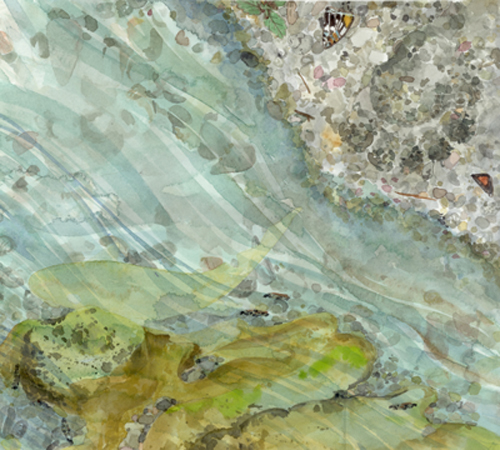Mother
Salmon In Dillon Creek
Dara Soto
She moves
fluidly,
with the grace
of a dancer despite the fact she is dying. A portion of her back, a graying
silver piece of flesh, pokes out from the surface of the shallow water.
Dillon Creek is crystal clear this last day of October. From my vantage
point on the rocky bank, I can see her entire exhausted body through the
water. Her redd is quite distinguishable; the mounds of cleaned off gravel
arranged in a row. Her precious pink eggs are hidden in the rocks to
protect them from predators and the elements. She eyes me nervously with her
watery lenses and continues to guard her babies with her scaly body
strategically positioned over the redd. Back and forth, back and forth…...it
is the relentless activity of a brooding mother protecting her young. The
soft flesh now hangs from her battered skeleton; the result of her long
journey to this spot from the ocean. How many logs, boulders, and culverts
did she encounter to cause this damage? How did she manage to travel to this
place, probably her birthplace, after so many years of being in the ocean?
Her ripped up tail is almost all bones—I can count how many are left as it
sticks up out of the water. This ragged tail is the badge of honor for all
spawning female salmon—the tell-tale sign of good nest making. She stays
over her eggs despite my presence. She stays there even though there are
bears, eagles, and osprey. She stays there despite her decaying body which
is weak and failing. Last bursts of energy are spent chasing away the hungry
little steelhead trying to sneak into the redd to gobble up her eggs. It is
a mother’s last ditch effort to take care of her babies before the final
throb of energy leaves her. There won’t be anyone to protect the eggs after
she breathes her last breath. Nobody will care as much as she does.

This
so-called “primitive” fish gives everything she has for the success of her
young. It is impressive that in her condition she remembers to stay there at
all! Even more remarkable is the fact that she will never see these eggs
hatch or see her salmon fry swim. Why should she care then? What makes her
stay there as her body slowly, painfully disintegrates? As a biologist I
want to ramble off facts about increased fitness, the passing of genetic
information, or instinctual survival mechanisms. But now as I approach
Bearfoot Painting by Sarah Hugdahl
motherhood, I have to say that the only explanation is that it must be love.
Only pure love could keep a being there as she takes her final breaths and
feels her body and mind painfully wrenched from her. No other reason seems
like it could be strong enough. A pregnant woman doesn’t even see her baby
until it is born in the ninth (or sometimes tenth!) month. What keeps her
eating right, exercising, and shoving down disgusting prenatal vitamins for
almost a year? The baby hasn’t even been born yet! What is this love that
knows no face, body, or spirit? Perhaps it is a universal phenomenon, a
common thread that connects all species. Beings simply want something to
care about. We are all bound through our common bond to care—for our young,
for others. It doesn’t matter what we look like; furry, scaly, fleshy, etc.
Nor is it important whether we live on land, in the air, or in the water.
We are all intertwined to each other through the ability to care for others.
Now some will argue that salmon are hardly capable of thinking, let alone
caring. I mean come on, they would say, the fish has a brain smaller than
the size of a pea! But I ask you this—imagine taking your last few breaths.
Would or could your final thought be of others?
Back to Short Stories Back to Index